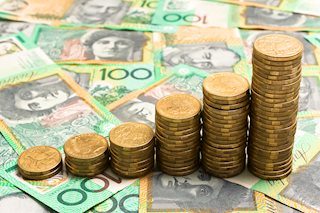AUD/USD strengthens above 0.6800 on RBA-Fed policy divergence, eyes on PBoC rate decision

AUD/USD trades firmer around 0.6810 in Friday’s early Asian session.
Fed officials pencilled in more rate cuts by year-end in their latest economic projections.
Investors will monitor the PBoC interest rate decision, Fed’s Harker speech on Friday.
The AUD/USD pair trades on a stronger note near 0.6810 during the early Asian session on Friday. The uptick of the pair is bolstered by the softer US Dollar (USD) amid the prospects of further rate cuts by the US Federal Reserve (Fed) this year. Later on Friday, the Fed’s Patrick Harker is set to speak.
The divergence of monetary policy between the Reserve Bank of Australia’s (RBA) higher for longer rate narrative and the Fed’s easing cycle is likely to influence the major pair in the near term. The two-day Fed meeting ended with an unexpected 50 basis points (bps) rate cut. The new dot-plots suggest a gradual easing cycle, with the 2024 median revised to 4.375% versus the 5.125% projection in June. Market expectations of the Fed rate cut might continue to undermine the Greenback and act as a tailwind for AUD/USD for the time being.
On the other hand, investors see the RBA keep its Official Cash Rate (OCR) unchanged at the upcoming meeting, but expect the rate cut later this year. Commonwealth Bank of Australia (CBA) analysts moved their expected timing of the first RBA rate cut from November 2024 to December 2024, with 25bp cut expected. “Recent strength in employment growth coupled with still relatively hawkish rhetoric from the RBA Governor means we now see December as the more likely month for the start of normalising the cash rate,” said CBA analysts.
The People’s Bank of China’s (PBoC) will announce its interest rate decision on Friday. Meanwhile, any development surrounding the weakness in the Chinese economy could weigh on the China-proxy Australian Dollar (AUD) as China is Australia's largest trading partner.
Australian Dollar FAQs
One of the most significant factors for the Australian Dollar (AUD) is the level of interest rates set by the Reserve Bank of Australia (RBA). Because Australia is a resource-rich country another key driver is the price of its biggest export, Iron Ore. The health of the Chinese economy, its largest trading partner, is a factor, as well as inflation in Australia, its growth rate and Trade Balance. Market sentiment – whether investors are taking on more risky assets (risk-on) or seeking safe-havens (risk-off) – is also a factor, with risk-on positive for AUD.
The Reserve Bank of Australia (RBA) influences the Australian Dollar (AUD) by setting the level of interest rates that Australian banks can lend to each other. This influences the level of interest rates in the economy as a whole. The main goal of the RBA is to maintain a stable inflation rate of 2-3% by adjusting interest rates up or down. Relatively high interest rates compared to other major central banks support the AUD, and the opposite for relatively low. The RBA can also use quantitative easing and tightening to influence credit conditions, with the former AUD-negative and the latter AUD-positive.
China is Australia’s largest trading partner so the health of the Chinese economy is a major influence on the value of the Australian Dollar (AUD). When the Chinese economy is doing well it purchases more raw materials, goods and services from Australia, lifting demand for the AUD, and pushing up its value. The opposite is the case when the Chinese economy is not growing as fast as expected. Positive or negative surprises in Chinese growth data, therefore, often have a direct impact on the Australian Dollar and its pairs.
Iron Ore is Australia’s largest export, accounting for $118 billion a year according to data from 2021, with China as its primary destination. The price of Iron Ore, therefore, can be a driver of the Australian Dollar. Generally, if the price of Iron Ore rises, AUD also goes up, as aggregate demand for the currency increases. The opposite is the case if the price of Iron Ore falls. Higher Iron Ore prices also tend to result in a greater likelihood of a positive Trade Balance for Australia, which is also positive of the AUD.
The Trade Balance, which is the difference between what a country earns from its exports versus what it pays for its imports, is another factor that can influence the value of the Australian Dollar. If Australia produces highly sought after exports, then its currency will gain in value purely from the surplus demand created from foreign buyers seeking to purchase its exports versus what it spends to purchase imports. Therefore, a positive net Trade Balance strengthens the AUD, with the opposite effect if the Trade Balance is negative.
* The content presented above, whether from a third party or not, is considered as general advice only. This article should not be construed as containing investment advice, investment recommendations, an offer of or solicitation for any transactions in financial instruments.


